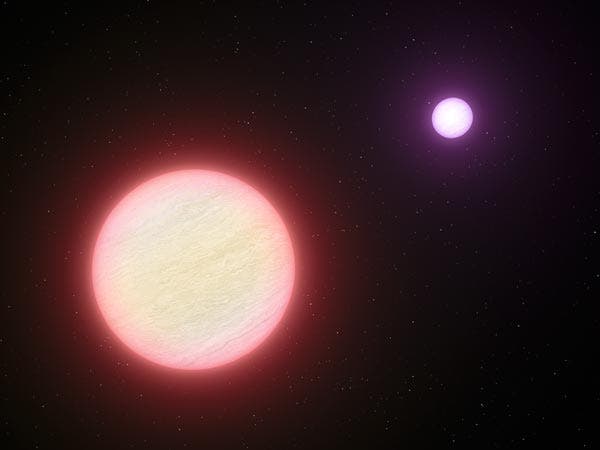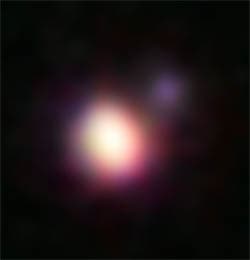
An artist's impression of the coldest brown dwarf found so far, CFBDSIR 1458 10b captioned on the right. Image (c) L. Calçada, ESO.
Astronomers usually classify stellar objects by a spectra going from hotter to cooler, using the letters O, B, A, F, G, K, and M. As observational technology progressed and a myriad of new astronomical findings were made, in the last 15 years alone two new classes L and T emerged designed to describe ultracool brown dwarfs. A recent scientific finding suggests that yet another spectra might need to be added to accommodate the coldest star discovered so far.
Dubbed CFBDSIR 1458 10b, the brown dwarf has a remarkably low surface temperature of 97 degrees C (206 degrees F) – just about as hot as a freshly made morning cup of coffee.
Over the years there has been steady but slow progress in pushing the boundaries of finding the coldest stars,” said study leader Michael Liu, an astronomer at the University of Hawaii were a team of researchers studied and published a paper about CFBDSIR 1458 10b.
“But with this latest discovery we have made a big leap forward—besting the previous record holder by at least 150 Kelvin [270 degrees F, or 150 degrees C],” he said.

Astronomers using the Keck II telescope recorded this composite infrared image of the brown dwarf binary designated CFBDSIR J1458+10. The fainter component is at present date considered the coldest star discovered so far. (c) Michael Liu - Univ. of Hawaii
CFBDSIR J1458+1013B did not cool down after starting out hot like our Sun, instead “it never became very hot in the first place because it developed from a fairly small cloud of gas,” said Duane Pontius, professor of physics at Birmingham-Southern College (BSC) in Alabama. “Gravity pulled the cloud together and compressed the gas, which heats it up just as a bicycle pump heats up when you compress air into a tire. But relative to brighter stars, there wasn’t as much gas, so this star never heated up much.”
This means that because it has such a low gravitational energy and mass, the dwarf was never able to sustain hydrogen fusion reactions in its core, which creates scorching high surface temperatures like 5,500 degrees Celsius on our own sun (a fairly low temperature compared to other stellar bodies). Astronomers at Keck II telescope, Canada-France-Hawaii telescope, and European Southern Observatory Very Large Telescop managed to describe CFBDSIR J1458+1013B after tracing it’s very dim infrared signature. The dwarf is paired in orbit with yet another dwarf star, the later a lot brighter though.
The study seems to gray the line between scientists decide what can be considered a planet and what can be considered a star, since CFBDSIR J1458+1013B is estimated to have a mass only 6 to 15 the mass of Jupiter, which has a surface temperature of -149 degrees C (-236 degrees F ).
“…this new object is so much colder than anything else seen that it now enters the regime where it may actually have an atmosphere with water clouds,” Liu said.
“The most exciting aspect of this finding is that we might be on the threshold of finding a new class of objects that blurs the line between gas-giant exoplanets and brown dwarf stars previously seen—something I think that is really surprising the astronomical community.”
You think CFBDSIR J1458+1013B is pretty cold for a star? Well, NASA scientists are trying to determine the exact temperature of a newly discovered brown dwarf, called WD 0806-661b, which is believed to have a temperature of roughly ~30 degrees Celsius and a mass 7 times that of Jupiter.
“I think it’s pretty neat to find a ‘star’ that could have a temperature similar to that of Earth,” says Kevin Luhman (Penn State University), who led one of the observing teams. Luhman and two colleagues used NASA’s infrared Spitzer Space Telescope to study WD 0806-661b, the companion of a faint white-dwarf star 63 light-years distant in the southern constellation Volans.
Story via skyandtelescope.com









